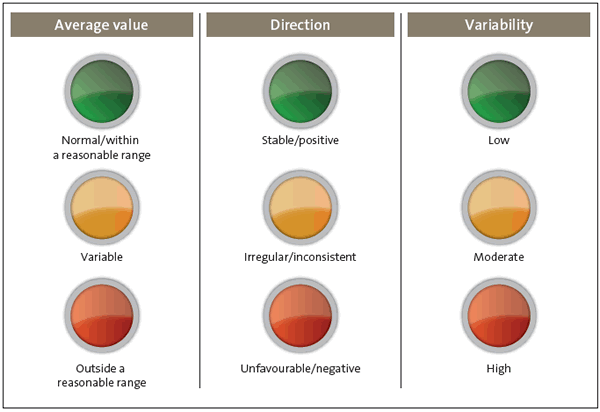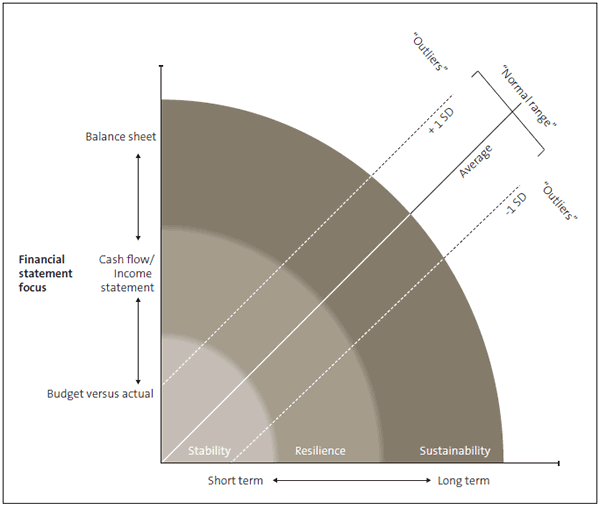Appendix 2: Our approach to better understanding financial trends
Our set of financial indicators
Comprehensively measuring and analysing a local authority's financial performance and position requires an understanding of a local authority's objectives, the risks to achieving those objectives, and the relationship between the two.
Financial statements are important in assessing financial performance and position. Although they say little about many of the operational objectives of public sector entities, they describe and summarise many of the factors that reflect the risk associated with achieving objectives (for example, through the underlying revenues, costs, liabilities, and assets).
An important part of the usefulness of financial statements is their ability to help a reader to understand financial uncertainty43 in a standardised and comparable way. This is a fundamental part of a local authority's performance story.
The potential financial risks in delivering on objectives for local government
Risks in the local government sector arise from many sources, including economic, political, and structural changes within and outside the local authority. Our approach does not attempt to identify and understand the root cause of risk. Instead, we use the financial statements to help assess the overall effect on three aspects that relate to local authorities' financial ability to deliver on their objectives:
- The stability of a local authority's activities (operations, capital, investing, and financing) is about how reliably a public entity plans, budgets, and uses financial resources. This refers to the ability to operate as planned. To help understand this component, we focus on financial information that shows how consistent and accurate these activities are (for example, by comparing actual performance with budget/forecast).
- The resilience of a local authority to short-term anticipated events reflects how well it can "bounce back". This refers to the ability to manage uncertainty. To help understand this component, we consider financial information that shows how well a local authority can respond without major structural or organisational change. For example, we look at cash flow and income statement items such as interest expense and rates, and balance sheet items such as current assets and current liabilities.
- The sustainability of a local authority looks at how prepared the public entity is for long-term uncertainties and to maintain itself indefinitely. This refers to the ability to invest for the future. To help understand this component, we consider financial information that indicates how longer-term uncertainties are being managed. We focus, for example, on balance sheet items such as assets, liabilities, and debt, together with related items such as capital expenditure, renewal expenditure, and depreciation.
To assess the potential risk involved in delivering on sector objectives, we assess, over consecutive financial periods, the relative values, direction, and distribution of various indicators within the three aspects. In other words, we assess:
- whether the average values are within a reasonable range and how they change − this indicates the relative position of public entities to deliver services in a stable, resilient, and sustainable manner; and
- the distribution of public entities that lie outside what we consider "normal" for the local government sector.
Greater variability implies more uncertainty in the public entity's relative position and ability to manage services in a stable, resilient and sustainable manner. We have used a traffic light system to summarise the results of our assessments (see Figure 12).
Figure 12
Traffic-light system to summarise the result of our assessments

Figure 13 provides a visual presentation of our approach. It shows how sustainable services are built on the stable and resilient services of an organisation, and how we summarise and portray the "normal range" throughout local government by using a standardised measure of variation on either side of the average – in other words, plus or minus one standard deviation.44
Figure 13
Outliers outside standard deviation from average

We use the term "norm" to refer to this range of one standard deviation either way from the average for the measure concerned.
To measure the variability between indicators, we consider the standard deviation and differentiate outliers that lie close to one standard deviation from the average and outliers that are more than two standard deviations from the average. We then analyse these figures collectively.
As with all analysis of financial performance, there are limitations to what we can infer. Our approach focuses on the potential for uncertainty and does not comprehensively assess the performance of local authorities. We are not trying to rank local government entities and what is shown as the normal range assumes a regularity that may not always be there. The outliers are not necessarily less certain to deliver on their objectives – they may simply warrant further investigation.
In considering trends, we have taken a more consistent approach to managing extreme results that can influence or distort our measures over time.45 Our approach is not to ignore or delete these very high or very low ratios but to transform (or cap) them at the 90th and 10th percentiles.
For most ratios, averages for local authorities do not change materially but, for all ratios, this capping process reduces variability and increases the number of outliers.
On balance, we consider the advantages of more consistency and comparability between ratios outweighs the disadvantages of standardising the data.
Figure 14 summarises the set of indicators that we have used.
Figure 14
Our indicators of financial performance
| Ability to operate as planned (stable services) | Ability to manage uncertainty (resilient services) | Ability to invest for the future (sustainable services) |
|---|---|---|
| Actual to budgeted cash applied to operations* | Current assets to current liabilities – working capital | Capital expenditure to depreciation** |
| Actual to budgeted capital expenditure | Enduring operating expenses to total operating expenses*** | Debt to total assets |
| Actual to budgeted debt | Interest expense to rates revenue | Net operating cash flows to capital expenditure**** |
* We have decided not to use the net operational cash flow variance but use instead an indicator that measures the difference in what was expected to be spent and what was actually spent on local authorities' operational needs.
** We have also considered renewal expenditure to depreciation.
*** Enduring operating expenses include employee benefits, interest, depreciation, and amortisation.
**** We have moved the indicator that considers how much capital investment is internally generated from the resilience analysis to the sustainability analysis. It has been replaced by an indicator that considers the flexibility of local authorities' cost structure – enduring operating expenses to total operating expenses. The indicator interest expense to debt, which shows the implied interest rate, has been removed from our set of indicators.
Indicators of ability to operate as planned
To consider the ability to operate as planned, we compare local authorities' actual cash flow applied to operations, the capital expenditure, and the debt balance with what was originally budgeted.46 A result of 100% indicates that planning was reliable and financial resources were used as intended.
Indicators of ability to manage uncertainty
The working capital indicator measures whether a local authority has enough resources to pay its debts as they fall due. A working capital percentage greater than 100% is generally considered preferable because that indicates that there are more resources available to respond to short-term unexpected events.
The enduring expenses to total expenses indicator measures the types of expenses that a local authority has little ability to influence while operations continue at current levels. Therefore, this measures the limitations to flexibility within which the local authority must operate.
The interest expense to rates revenue indicator shows the proportion of rates revenue that is required to service debt.47 A higher percentage means less flexibility to respond to unexpected events.
Indicators of ability to invest for the future
The capital expenditure to depreciation indicator is used because depreciation is a reasonable estimate of the capital expenditure needed to maintain the asset base.48 A better indicator is the replacement of assets to depreciation.
Local authorities typically call replacement of assets "renewals". An asset renewals ratio above 100% may indicate that the asset base is being managed in a sustainable way.
Before 2012/13, local authorities were not required to separately show renewals in their financial statements. Because this information, along with comparatives, is now available, we have also considered this indicator.
The proportion of gross debt to total assets indicates a local authority's capability to control and manage its longer-term financial uncertainties. For example, a result of 10% means a local authority has debt equivalent to 10% of assets. This indicator considers debt as a source of funding assets and the influence that external funders may have on the public entity.
The indicator comparing net cash flows from operations to capital expenditure shows the cash surplus available for use for capital expenditure. A higher percentage indicates a local authority is better able to pay for capital expenditure using internally generated funds rather than relying on external sources.
43: The terms "risk" and "uncertainty" can have different meanings. For simplicity, we use the terms interchangeably to mean the potential for variation from what is expected or considered "normal". For instance, a public entity's large operating surplus can be as much an indicator of uncertainty (or risk) as if it had a large operating deficit.
44: Standard deviation is a statistical measure of how far the data points are spread. A small standard deviation indicates that the data points tend to be close to the average. A larger standard deviation indicates that the data points tend to be further from the average.
45: We also consider and discuss some individual entity ratios where, for example, they are notable outliers. In these instances, we show the entity ratios in their uncapped form.
46: Capital expenditure is spending on property, plant, equipment, and intangible assets.
47: To calculate this indicator, we have used the interest expense as stated on the face of the statement of comprehensive income/income statement. The sector uses different terms to express this item, including finance cost, finance expense, or interest expense. In some instances, interest expense might include finance cost/expense items other than interest relating to borrowing, such as unrealised losses and gains on financial derivatives.
48: Depreciation reflects the depreciation expense for property, plant, and equipment and amortisation expense for intangible assets.

